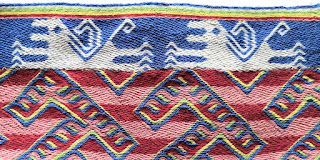Reconstruction of woman's clothing from Halstatt period

Ever since I was preparing myself for my first performance as a Hallstatt weaver at a prehistoric (multi-period) event Krumbenowe , I knew that I wanted a costume different from a peplos worn by most of the women representing La Tene Celts. As the non-archaeological public is not familiar with the dating of fibulae and jewelry, I wanted to have something more different. Although no complete dress from the Early Iron Age has been preserved, we have at least an approximate idea of it thanks to so-called situla art. Back then I quickly sewed from materials I had at hand a costume that approximately corresponded to these images, but I wished to make later a more accurate reconstruction of clothing from one particular picture (of course, I chose the most complicated one!) using textile patterns from Hallstatt and other sites from the Early Iron Age. In contrast to a straight dress reaching mid-calf and a cloak or veil of various lengths worn by most women depicted in situla art, a woman ...








